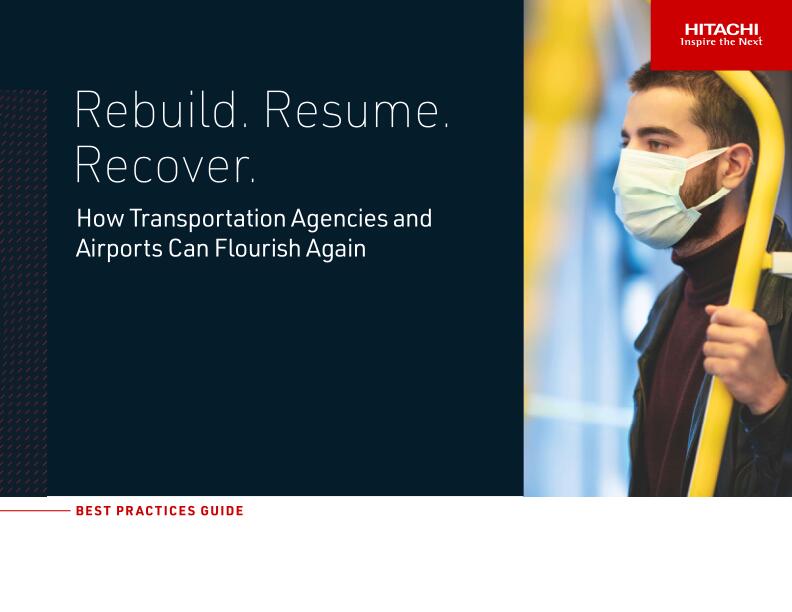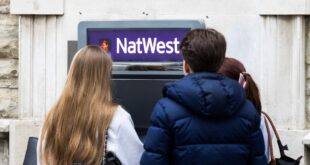Rebuild. Resume. Recover How Transportation Agencies and Airports Can Flourish Again
Read our whitepaper that provides five steps that will help transport operators rebuild, resume, and recover. In this guide, Hitachi explain how digital technologies can improve safety, build a foundation for the future, and improve efficiencies across the board. We’ll also share our contact details, so you know who to contact.
Download the whitepaper now.
by Hitachi
Thank you.Please check your email to download the Whitepaper.
In this article Shamik Mehta, Director of Industry Solutions Marketing at Hitachi Vantara, explains how smart technologies are helping transport operators transition from unprecedented crisis to unprecedented opportunity.
New revenue streams en route
Digital transformation is a necessity across all sectors and industries. According to Statista, spending on digital transformation is projected to reach 1.78 trillion by 2022. Shamik says it’s the same story in transportation, where it is an important way to provide safe, green and efficient services in a post-Covid world.
“Digital transformation gives transit operators better visibility into their organization’s data and helps them find new ways to generate revenue when traditional lines are shrinking,” Shamik explains. “For example, if you consider fleet electrification — a project Hitachi Vantara is leading — the impact on the energy grid is going to be dramatic. Digital transformation will help them understand how to serve these new customers. It’s a revenue opportunity for everyone involved.”
Shamik is talking about Optimize Prime Hitachi, a pilot program in the London area with partners Uber, The UK Power Network (UKPN), Centrica, and The Royal Mail. The aim is to discover what would happen if a company, like The Royal Mail, electrified a significant portion of its mail-delivery van fleet and employed EV fleet management. What does that mean for routes? Where and when should they charge? What are the electricity rates? What impact will it have on the grid if they all started charging at their depot at the same time? This can have profound impacts on generating new business models: what if a city builds a parking garage just for EVs, and EV owners could opt-in to allow the building to sip energy out of their EV batteries: could the building turn into a temporary power source, in exchange for free or discounted parking rates?
“It’s easy to imagine a world where the city then offers free parking to the Royal Mail, or redeemable credits for charging, or free charging during a period of low demand. It’s a win-win situation for both operators that’ll help them find efficiencies or new revenue streams.”
Uber and Lyft are using digital transformation to offer new revenue streams too. In some US cities, Uber is already experimenting with subscription models, such as offering discounts on rides and food deliveries for a flat monthly fee – we shall soon see packages that offer a fixed number of free rides for a monthly subscription.
Services like these would not be possible if not for customers adopting more digital technologies. Mobile apps make it possible for transport operators to create networks for businesses within their ecosystem, for example Starbucks can offer in-app discounts or subscription services to passengers traveling in their zones. Businesses can be injected into these ecosystems to serve customers along the entire journey, creating a better user experience and a win-win for operators and partner businesses.
Driving efficiencies
This can be seen in effect in Hitachi’s work with Capital Area Transit System (CATS) in Baton Rouge, Louisiana. With Hitachi’s guidance, CATS launched its Route Shout 2.0 app on the Apple Store and Google Play store. The app tracks CATS buses as they move through the transit network and informs riders when there is a route change. It then uses a GPS function that points travellers to the closest bus stop. Hitachi IoT and data analytics services can send ride alerts to the app as well as pop-ups for discounts and location-based services.
“If everyone uses an app like Route Shout, rider information is available to the transit business, even to the bus driver, if necessary, so they get an idea of capacity,” Shamik explains. “If capacity is low, they can take a smaller bus and save on fuel. Knowing the route also helps transit operators optimize the route for electric vehicles, perhaps rerouting automatically via overhead charging stations to increase efficiency.”
Hitachi’s LIDAR and AI can also monitor the vehicles to tell when maintenance is required. That includes everything from when to replenish fluids to the optimum time to change wheelsets on trains, avoiding unnecessary replacement of expensive components. It is also being used for the maintenance of transit routes and signage, Shamik says. Hitachi has mounted cameras on the front of trains, for example, which scan to ensure that all the signs are working correctly, in the right place, are undamaged and fully visible. They have also been used to ensure the integrity of the tracks, or to ensure maintenance crews are being used efficiently. Another example is managing passenger flow and volume. This data is helping transport operators capitalize on opportunities that existed but could not be identified without the necessary equipment, data and analysis.
When the layover becomes a preference
The most exciting thing about airports is the range of people you get in one place at one time, Shamik says. This represents an opportunity for transport providers to create experiences for customers. Shamik paints a picture of the airport of the future where travellers will show up early to attend events, whether a TED Talk, with some international speaker flown in the address an audience, or some networking event that an app has pinged you about. He says the airport of the future will act like a small global city where there are innumerable opportunities to connect with people from around the world. A stopover or layover could therefore become a part of the trip you look forward to.
“Imagine a networking event that works like a dating app except it’s for LinkedIn,” he explains. “Pre-flight, your app links to your calendar and says, ‘this person is going to be here, do you want me to schedule that.’ Or those with an interest in chess might be alerted that a great chess player is in the airport for a fun and productive experience. You could have education, universities that offer classes — at each airport, you could go to a lecture. Really, these things are available now and open the door for new revenues. Businesses are poised to take the leap.”
Transit operators across the world are modernising fast, so it’s important to take advantage of the support available to transport operators and start on this journey sooner rather than later. For example, in March 2021, the US government signed a $1.9 trillion coronavirus aid package that includes $360 billion in direct allocations for state and local governments and transportation agencies to help them get back on track. Now is an incredible opportunity to tap into such opportunities and lay a digital foundation that will propel transport providers into the future, Shamik says.
To find out how Hitachi Vantara’s technologies can help you, download the complimentary whitepaper.

Rebuild. Resume. Recover How Transportation Agencies and Airports Can Flourish Again
Read our whitepaper that provides five steps that will help transport operators rebuild, resume, and recover. In this guide, Hitachi explain how digital technologies can improve safety, build a foundation for the future, and improve efficiencies across the board. We’ll also share our contact details, so you know who to contact.
Download the whitepaper now.
by Hitachi
Thank you.Please check your email to download the Whitepaper.
Source link



